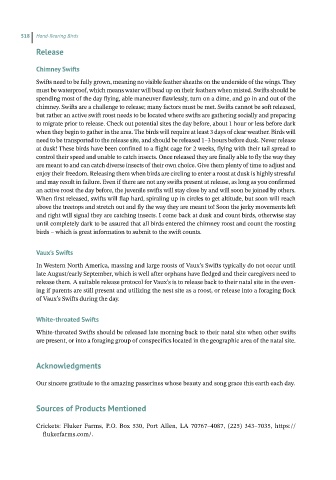Page 521 - Hand rearing birds second
P. 521
518 Hand-Rearing Birds
Release
ChimneySwifts
Swifts need to be fully grown, meaning no visible feather sheaths on the underside of the wings. They
must be waterproof, which means water will bead up on their feathers when misted. Swifts should be
spending most of the day flying, able maneuver flawlessly, turn on a dime, and go in and out of the
chimney. Swifts are a challenge to release; many factors must be met. Swifts cannot be soft released,
but rather an active swift roost needs to be located where swifts are gathering socially and preparing
to migrate prior to release. Check out potential sites the day before, about 1 hour or less before dark
when they begin to gather in the area. The birds will require at least 3 days of clear weather. Birds will
need to be transported to the release site, and should be released 1–3 hours before dusk. Never release
at dusk! These birds have been confined to a flight cage for 2 weeks, flying with their tail spread to
control their speed and unable to catch insects. Once released they are finally able to fly the way they
are meant to and can catch diverse insects of their own choice. Give them plenty of time to adjust and
enjoy their freedom. Releasing them when birds are circling to enter a roost at dusk is highly stressful
and may result in failure. Even if there are not any swifts present at release, as long as you confirmed
an active roost the day before, the juvenile swifts will stay close by and will soon be joined by others.
When first released, swifts will flap hard, spiraling up in circles to get altitude, but soon will reach
above the treetops and stretch out and fly the way they are meant to! Soon the jerky movements left
and right will signal they are catching insects. I come back at dusk and count birds, otherwise stay
until completely dark to be assured that all birds entered the chimney roost and count the roosting
birds – which is great information to submit to the swift counts.
Vaux’sSwifts
In Western North America, massing and large roosts of Vaux’s Swifts typically do not occur until
late August/early September, which is well after orphans have fledged and their caregivers need to
release them. A suitable release protocol for Vaux’s is to release back to their natal site in the even-
ing if parents are still present and utilizing the nest site as a roost, or release into a foraging flock
of Vaux’s Swifts during the day.
White-throated Swifts
White-throated Swifts should be released late morning back to their natal site when other swifts
are present, or into a foraging group of conspecifics located in the geographic area of the natal site.
Acknowledgments
Our sincere gratitude to the amazing passerines whose beauty and song grace this earth each day.
Sourcesof ProductsMentioned
Crickets: Fluker Farms, P.O. Box 530, Port Allen, LA 70767–4087, (225) 343–7035, https://
flukerfarms.com/.

